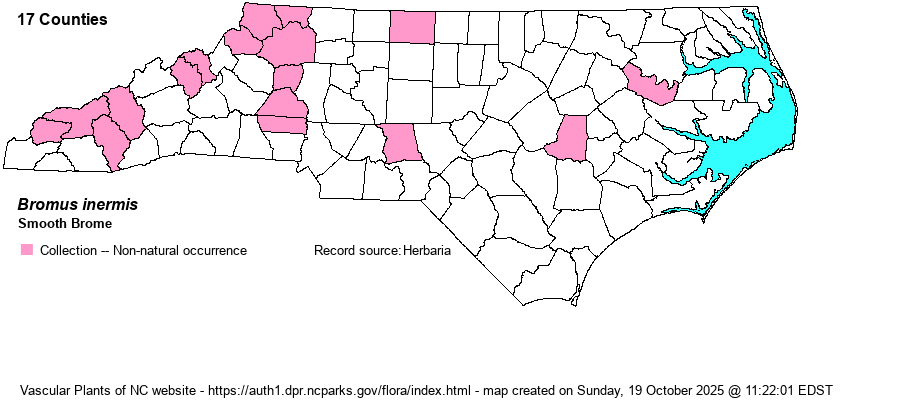| Author | Leysser | |
| Distribution | Mostly Mountains; scattered in the Piedmont and Coastal Plain.
Native to Asia; in N.A. from Lab. to AK, south to NC, TX, and CA. | |
| Abundance | Uncommon in the Mountains and upper Piedmont; rare in the lower Piedmont and Coastal Plain. | |
| Habitat | Roadsides, fields, meadows, disturbed soils, waste ground. | |
| Phenology | Flowering and fruiting June-July. | |
| Identification | Smooth Brome is a tall grass (2.5-4.5 feet) with glabrous or glabrate stems, leaf sheaths, and spikelets. The spikelets lack awns. Plants grow rather colonially from horizontal rhizomes. | |
| Taxonomic Comments | Bromus is an important genus of grasses for their value as forage (many species) or for the harm they cause to the guts of grazing animals (a few species). In most of our species, inflorescences arch over and cause the spikelets to droop; thus the plants are often graceful looking. Bromus, Festuca, and Poa all can look quite similar to beginners (and even veterans!), because they all have multi-flowered spikelets. Generally speaking, Bromus taxa have much the largest spikelets, and most Poa taxa have a tuft of wispy hairs at the base of each floret (lacking in the other genera). Bromus and Festuca taxa have obvious awns on the florets that are absent in Poa taxa. With field experience and careful use of keys, one can eventually handle these genera. | |
| Other Common Name(s) | | |
| State Rank | SE | |
| Global Rank | G5 | |
| State Status | | |
| US Status | | |
| USACE-agcp | UPL link |
| USACE-emp | UPL link |

